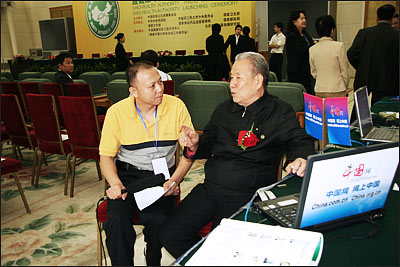The Constitution of the People's Republic of China guarantees
citizens' freedom of speech and information. Since the 1980s, the
mass media are growing more diversified as they extend their reach
throughout China through a multiplicity of transmission methods
including satellite, wireless and wired systems. Today there are
over 2,000 newspapers, over 9,000 magazines, 273 radio stations and
352 TV stations. By the end of 2005, there were 774 medium- and
short-wave radio transmitting and relay stations, 125.69 million
households with access to cable television, and 1.22 million
households in 30 cities with access to cable digital television,
covering 94.5 percent and 95.8 percent of the population
respectively
News Agencies
Headquartered in Beijing, Xinhua News Agency is China's official
news agency, as well as one of the world's major news agencies with
more than 100 branches in Asia-Pacific, the Middle East, Latin
America, Africa and other regions. In 2003, its subordinate Xinhua
Financing Network Ltd. formed an international alliance with Agence
France-Presse (AFP) of Finance. Xinhua Financial Network Ltd.
purchased the news agencies of AFP Asian Finance in Hong Kong,
Japan, South Korea, and Singapore and eight other Asian countries
and regions, which expanded the coverage of Xinhua News Agency's
international network.
China News Service, also Beijing-based, mainly supplies news to
overseas Chinese, foreign citizens of Chinese origin, and
compatriots in the Hong Kong Special Administrative Region, the
Macao Special Administrative Region, and Taiwan.
Newspapers
Between 1950 and 2000, the number of Chinese newspapers increased
nearly ten-fold. In 2005, more than 1,000 kinds of daily newspaper
were published in China, with their circulation reaching 100
million, the highest figure of any country in the world. Targeted
at different reader groups, newspaper formats are becoming
increasingly diverse and colorful. Recent years have seen an
important trend of newspaper reorganization. To date, 39 newspaper
groups have been established, for example, Beijing Daily Newspaper
Group, Wenhui Xinmin Associated Newspaper Group and Guangzhou Daily
Newspaper Group. Since 2003, trans-regional cooperation among the
print media has become a new trend. The Beijing News, invested and
run by the Guangming Daily Newspaper Group and the Nanfang Daily
Newspaper Group, was the first to receive formal government
approval to publish trans-regionally. Not to be left out,Shanghai
also presented Orient Observation Weekly, its largest shareholder
being the Beijing-based Xinhua News Agency.
Radio
China National Radio, China's official radio station, has
nine channels broadcasting a total of 200 hours per day via
satellite. Every province, autonomous region and municipality has
its own local radio stations.
China Radio International (CRI) is the only state-level radio
station targeting overseas audiences. It has 300 hours of programs
daily beamed across the globe in 38 foreign languages, Mandarin
Chinese and four Chinese dialects. The programs cover news, current
affairs, comment, entertainment, as well as politics, economy,
culture, science and technology. Currently, CRI ranks third in
overseas broadcasting time and languages among the world's overseas
service radio stations.
Television
China's television industry has become a complete system with
high-tech program production, transmission and coverage. China
Central Television (CCTV), China's largest and most powerful
station, has business relations with more than 250 television
organizations in over 130 countries and regions. Following a global
television industry trend, CCTV has moved toward specialization,
introducing three specialized channels -- News and Children's
Program in 2003, and Music in 2004.
Altogether there are 3,000 television stations across the
country. Large international expositions, including the Shanghai
Television Festival, Beijing International Television Week, China
Radio and Television Exposition and Sichuan Television Festival,
are held on a regular basis. Besides judging and conferring awards,
these festivals conduct academic exchanges and the import and
export of TV programs. Shanghai has grown into Asia's largest
television program trading market.
The Internet
Since the mid-1990s, China's traditional media have been
supported with online media and of China's 10,000-odd news media
across the country, 2,000 have gone online. Quite a number of
famous websites have begun to appear, relying on information flow
from the news media, and taking advantage of the latter's superior
news coverage. Experts predict the merging in the 21st century of
traditional and internet media into a multi-media news platform
combining sound, image and text.
 |
Wowzine, established by www.southcn.com in August 2005, is one
example of the wildfire expansion of online magazines. Since TV
programs became available on cell phones via the whole network of
China Mobile in September 2005, China Mobile has recruited over
150,000 subscribers to such services. There are three main ways of
sending news media images and text to palmtops -- SMS messages,
cell-phone reports and WAP sites. Many news websites are trying out
"cell-phone newspapers." The China Daily website, for example, has
developed a Chinese-English information service system to send the
latest images and text reports on major happenings in China to
subscribers' cell phones.
On January 1, 2006, www.gov.cn, the official website of the
Chinese government formally opened as a comprehensive platform for
the State Council and subordinate departments, and for governments
at all levels to release information and offer online services.
Multi-media Groups
Since China entered the WTO, the trend within China's media
industry has been to form inter-media and trans-regional media
operated on multiple patterns so as to meet competition and
challenges from powerful overseas media groups. In 2001, the
government put forward a goal of establishing trans-regional
multi-media news groups. It also instituted detailed regulations on
fund raising, foreign-funded cooperation and trans-media expansion.
The China Radio, Film and Television Group, founded in 2001,
integrated the resources of central level radio, television and
film organizations plus those of the many radio, television and
Internet companies, to become China's biggest and strongest
multi-media group, covering television, Internet, publishing,
advertising, etc.
China's media are cooperating with overseas media groups. Since
2003, 30 overseas television stations, including Phoenix Satellite
TV, Bloomberg Finance, Star TV, Euro Sports News and China
Entertainment TV have landed, with conditions, on China's mainland.
At the same time, CCTV's English language channel has reached US
audiences via the News Group's Fox News Network.